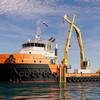(The tug Kesarin 10 at sea trials on the Chao Phrya River near the ancient Thai capital of Ayuthya.
C.S. Inter Marine’s shipyard manager Khun Patum Sardsiri is a practical man. He works with management to balance costs and benefits through out the company’s sizable fleet of tugs, barges and bulk cargo handling stations. In some cases this can result in relatively large expenditures, such as one made recently to swap engines on a one year old boat. The handy little steel tug had been launched with a 500 HP second hand engine that quickly began accumulating costs in down time and repairs.
When management made the decision to replace the engine with a brand new Cummins KTA19 M3 rated 640 HP at 1800 RPM, Khun Patum pulled the boat up on the bank at the company shipyard in the ancient Thai capital of Ayuthya some 50 miles up from the Gulf of Thailand. The old engine came out easily through purpose-built skylight. At the same time Khun Patum had the 7:1 gear pulled along with the shaft and four-blade 75x16-inch propeller for service and inspection.
With the shaft sitting out on a bench, he explained to a visitor the cost to benefit advantages of the Tamarind wood bearings that he uses in the company tugs. “A vinyl bearing costs about 90,000 baht ($2,500 US) while I can have these made for only 3,000 baht ($75.00 US)”
In America, lignum vitae wood was used for many years in shaft bearings. Writing in Power Transmission Design Magazine, Managing Editor Tom Hughes reported, “…early users of wood bearings (bearings with no impregnation of additional lubricant) were ship builders and woodworking shops making underwater shaft bearings for tugs and freighters. The natural resins inhibited water absorption and served as a base for a water film between bearing and shaft… Wood bearings operate well in abrasive environments. Gritty particles that manage to reach the bearing surface embed harmlessly in it.”
Demonstrating the good and minimal wear of the year-old bearing, Khun Patum explains that he carefully selects a tamarind log from a tree that is at least 20-years-old. The last one he purchased for 2,500 baht. After aging one week in the shade, he had eight (four sets of two) bearings turned at a local lumberyard. The two-foot long tail bearing for this shaft has an 8-inch interior diameter with 5/8-inch walls while the forward bearing keeps the same diameter but is 16 inches long. “I normally inspect the bearings every three years but they will last indefinitely if we keep a good water flow over them to lubricate and remove the river’s sand,” he explained.
In doing a cost benefit analysis it may be that new machinery is the best investment, but in others it may be that staying with the tried and true is the best course.
Subscribe for
Maritime Reporter E-News
Maritime Reporter E-News is the maritime industry's largest circulation and most authoritative ENews Service, delivered to your Email five times per week










